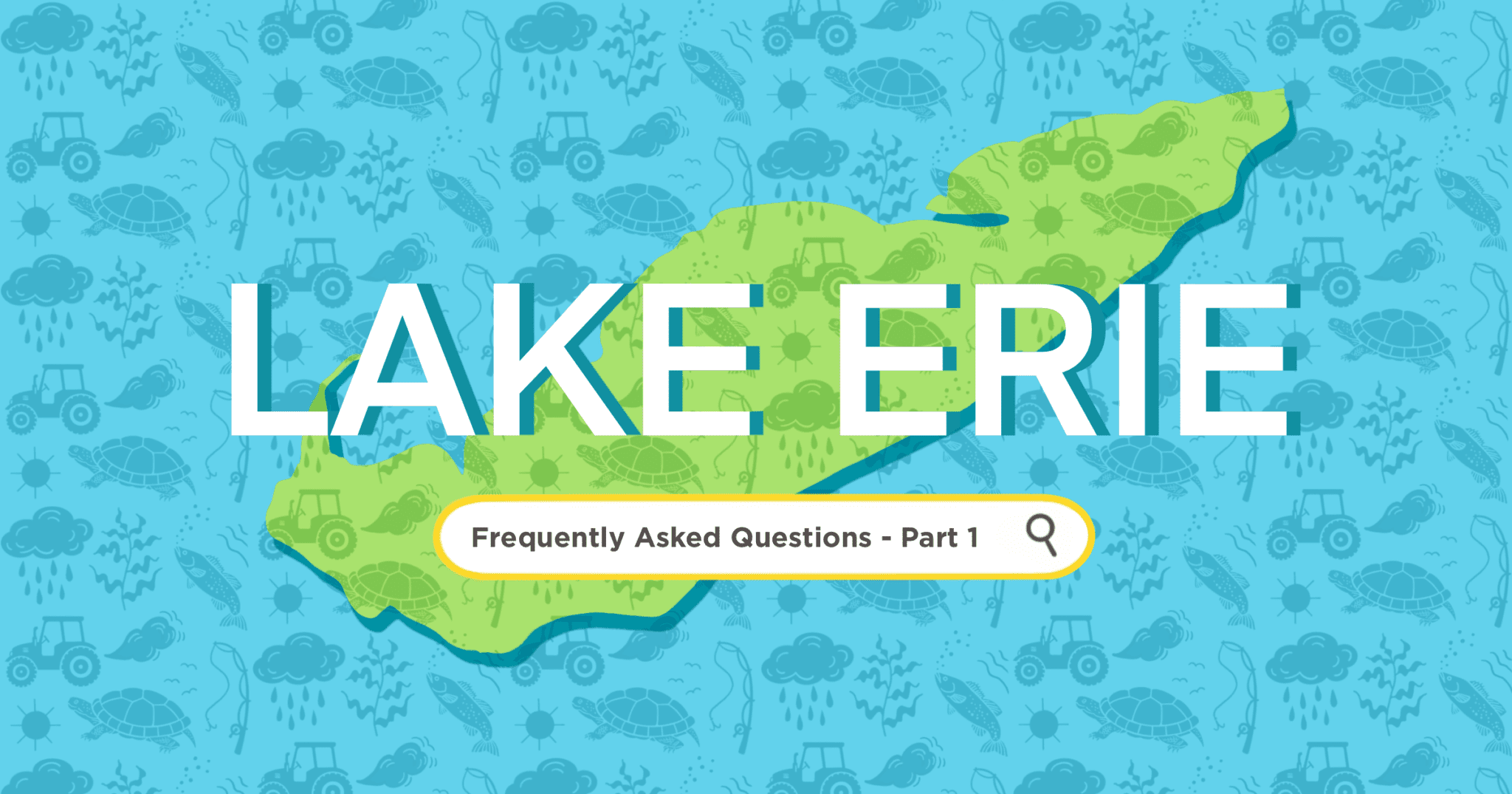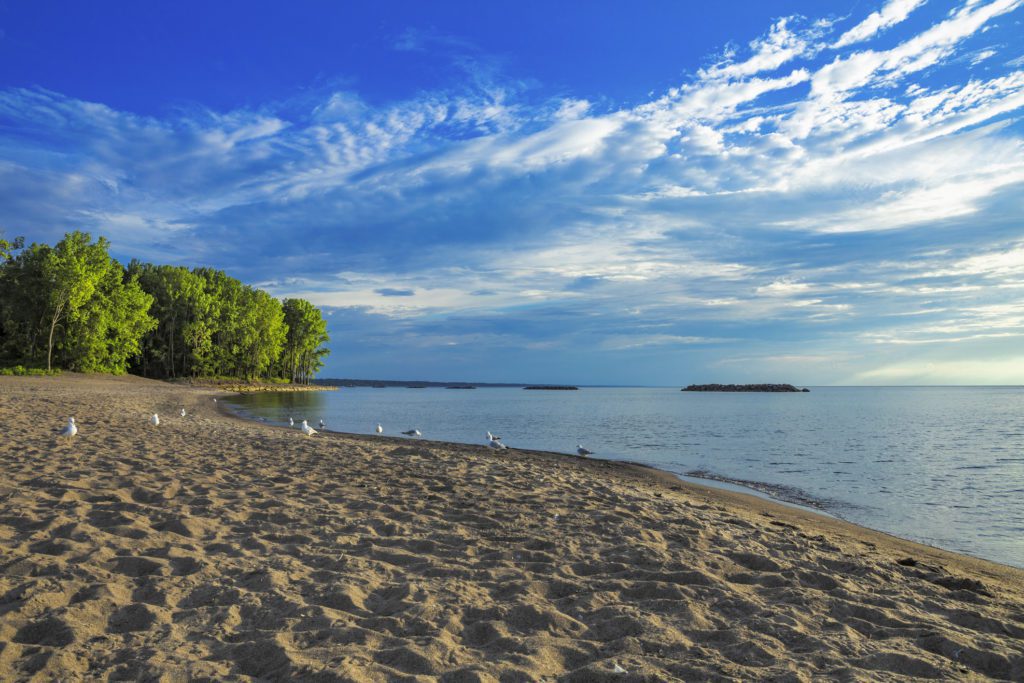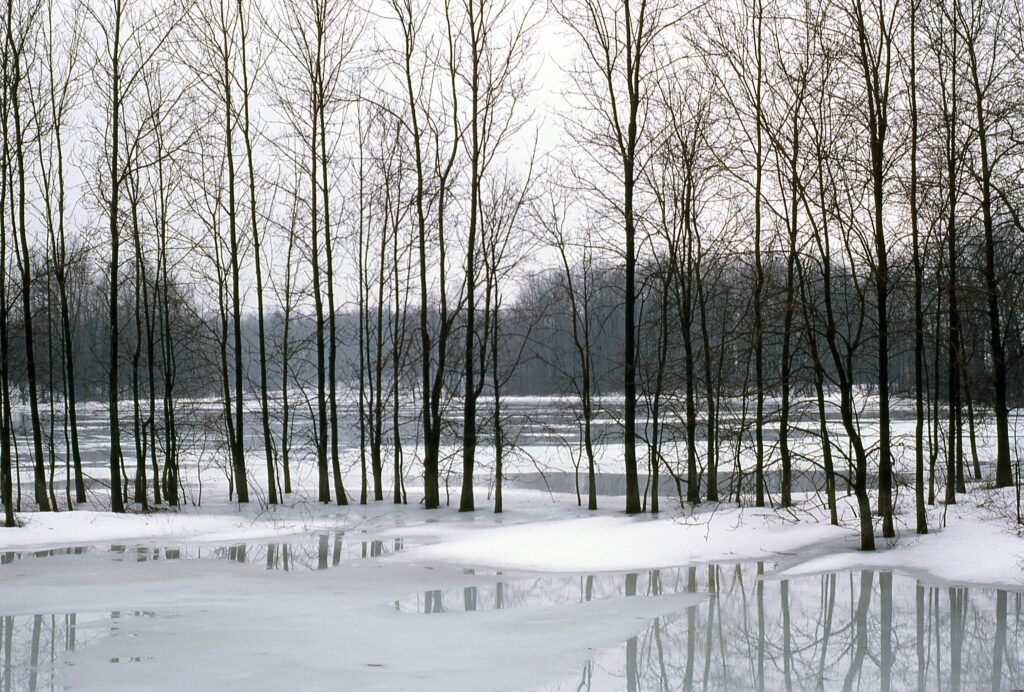This blog is co-authored with Michelle Woodhouse, Water Program Manager

You may have found yourself googling these questions after reading headlines about the annual toxic algae bloom that plagues Lake Erie, devastating the lake’s ecosystems and impacting its water quality. We have compiled answers to frequently asked questions about Lake Erie. In the first of this two-part blog series, we address your questions from “Why is Lake Erie important?” to “What is the name of Lake Erie’s mythical sea monster?”
The Great Lakes
There are five Great Lakes in North America: Lake Superior, Lake Huron, Lake Michigan, Lake Erie and Lake Ontario.
The Great Lakes hold 84 per cent of North America’s surface freshwater, provide drinking water for over 40 million people, and support billion-dollar economies. These essential bodies of water face many problems, including threats from pipelines and oil spills, nutrient pollution and toxic algae blooms, climate change, plastics, road salts, toxic chemicals, invasive species, loss of forests and wetlands, and more. 
Where is Lake Erie located?
Lake Erie is the southernmost of the five Great Lakes. The lake sits on the international boundary between Canada and the United States, with shorelines in Ontario, Michigan, Ohio, Pennsylvania, and New York. Lake Erie is also within the traditional Indigenous territories of the Haudenosaunee and the Anishinaabeg, who have inhabited the region for over 10,000 years.
The Lake Erie watershed is home to about one-third of the total human population of the Great Lakes basin. Approximately 12 million people live in the watershed, including 17 metropolitan areas.
What are Lake Erie’s defining features?
Lake Erie is the shallowest and smallest Great Lake by volume; it is only 210 feet deep at its deepest point. By comparison, the deepest Great Lake, Lake Superior, has a maximum depth of 1,332 feet.
Eighty per cent of Lake Erie’s water enters through the Detroit River, and most of the water exits through Niagara Falls, which connects Lake Erie to Lake Ontario.
Lake Erie is naturally divided into three distinct basins:
- The western basin is very shallow, with a maximum depth of 62 ft. It is the most turbid region of Lake Erie due to fine sediment particles that cover the bottom of the lake. These particles easily get churned up by wind and waves.
- The central basin has a maximum depth of 82 ft.
- The eastern basin is the deepest of the three basins, with a max. depth of 210 ft.
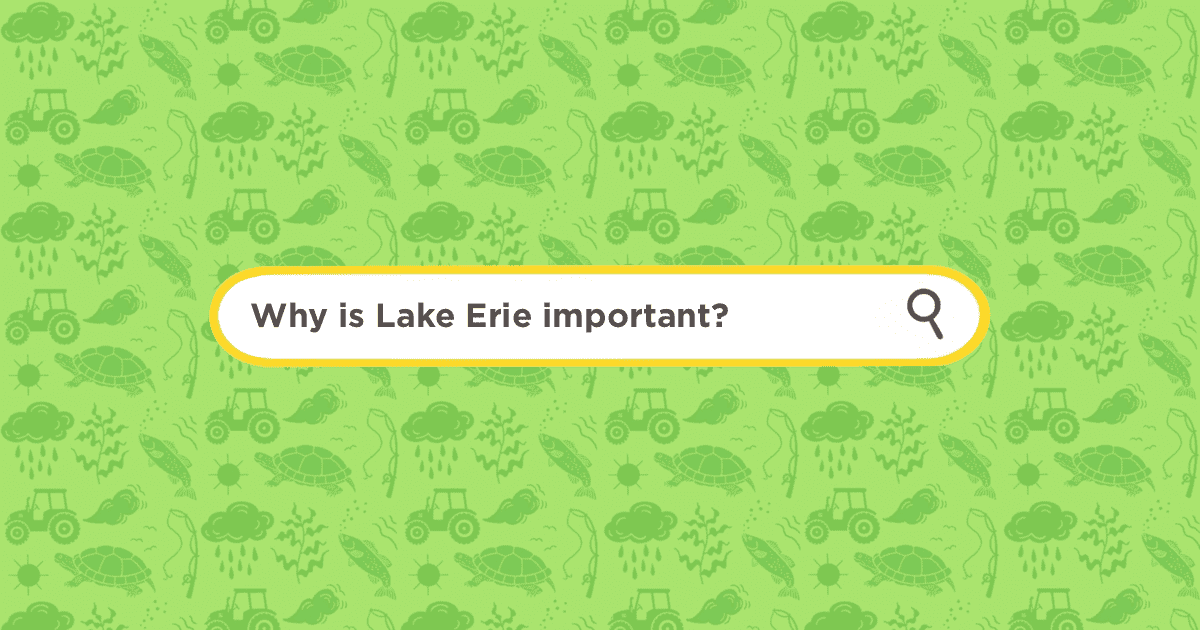
A critical ecosystem for thousands of species
Lake Erie is the most biologically diverse of all the Great Lakes due to its warm, shallow waters. The lake is home to 107 fish species and is known as the Walleye capital of the world. Lake Erie is also a critical stopover for thousands of songbirds, shorebirds, waterfowl and butterflies, including the Monarch butterfly.
FUN FACT: Monarchs start their 4000 km migration by flying 80-95 km across Lake Erie in one go. Point Pelee National Park is a resting spot for thousands of monarch butterflies for a few days each autumn.
Lake Erie’s north shore houses some of Canada’s most species-rich wetlands. These wetlands are home to many species at risk, including the Blanding’s turtle, spiny softshell turtle, northern map turtle, snapping turtle, spotted turtle, eastern fox snake and Fowler’s toad.
An important source of drinking water
Approximately 12 million people get their drinking water from the Lake Erie watershed.
Note: Lake Erie’s water quality is threatened by nutrient pollution, which leads to toxic algae blooms. In 2014, we saw how much damage a severe algae bloom can have on society when the presence of microcystin (a potent toxin and possible human carcinogen produced by algae blooms) left nearly 500,000 residents in Toledo, Ohio and Pelee, Ontario, without access to safe drinking water for days.
Supports local economies
- Lake Erie supports billions of dollars in commercial and recreational fisheries and provides jobs for over 10,000 people.
- We eat more fish from Lake Erie than the other Great Lakes combined, even though it is the smallest lake by volume.
- Half of Canada’s prime agricultural land is situated between Lake Erie’s northern shores and Lake Ontario’s southern shores.
- Lake Erie’s southeastern shores produce significant amounts of concord grapes due to its nutrient-rich soil. The region even earned the nickname “The Concord Grape Belt.”
- Lake Erie supports a $12.9 billion tourism industry.
A beloved location for recreation and leisure
- Lake Erie hosts the world’s largest freshwater commercial and sports fisheries. In fact, Lake Erie is considered the walleye (yellow pike) capital of the world. Port Clinton even hosts an annual New Year’s Eve event called the Walleye drop, where partygoers eat perch and watch Wylie, a 20-foot-long and 600-pound fibreglass walleye, drop at midnight.
- Point Pelee National Park on Lake Erie is a popular spot for watching migratory birds throughout the year and monarch butterflies in the fall.
- Lake Erie has many popular sandy beaches where people swim, enjoy water sports and explore the local towns, including Port Dover, Long Point and Turkey Point.
- Lake Erie is a favourite spot for divers because there are 270 confirmed shipwreck locations to explore.
- The lake is also a popular destination in the winter for ice fishing and snowmobiling. Hundreds of people take their winter use of the lake even further by participating in an annual Polar Bear plunge to kick off the New Year.
FUN FACT: Lake Erie has its own mythical lake monster named Bessie. The legend of the serpentine creature living in Lake Erie actually originated in First Nations culture. First Nations groups in the Lake Erie region, particularly the Iroquois tribe, would speak of Oniare (“own-yar-eh”), a water spirit that lives in the Great Lakes. The name “Oniare” is the Mohawk word for “snake.” She is also known as the “Great Snake of Lake Erie,” the “Lake Erie Monster,” and “South Bay Bessie.”
Cultural/spiritual connection and significance
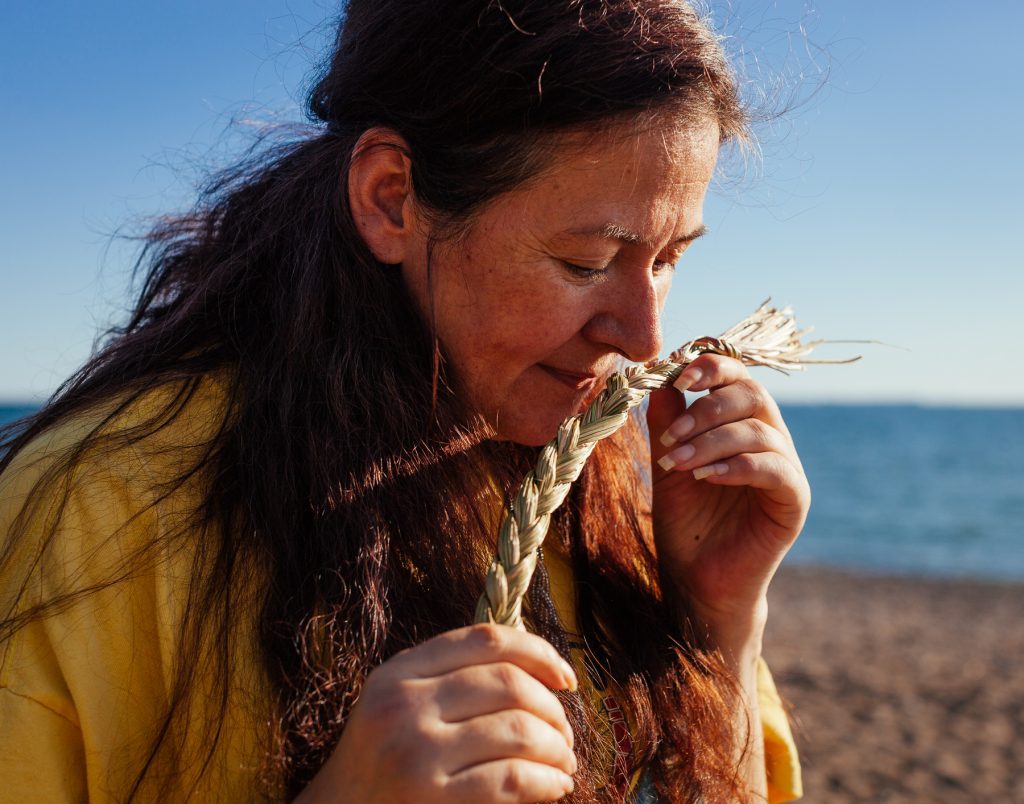
- For over 10,000 years, Indigenous peoples such as the Anishinaabeg and Iroquois have inhabited what is now known as Lake Erie.
- Along with the rest of the Great Lakes, Lake Erie has played an integral role in Indigenous ways of living. The waters and lands are tied directly to important teachings and creation stories passed down since time immemorial. These teachings provide the original instructions for Indigenous peoples on living in harmony with the natural world and with “all our relations” – the people, animals, birds, insects, trees and plants, rocks, rivers, mountains and valleys.
- For Indigenous peoples of this area, Lake Erie is connected to integral ways of life, and the essence of their core being is tied to the lake.
- For many centuries, Indigenous Nations across Turtle Island/North America have practiced gratitude and respect for all of creation through traditions and ceremonies, which differ across nations. These cultural practices include water ceremonies, naming ceremonies, full moon ceremonies, sweat lodges, pow-wows, and strawberry ceremonies.
- In addition to Lake Erie’s cultural and spiritual importance to Indigenous peoples, this watershed is filled with residents from diverse cultures and backgrounds.
- Water and the natural world have always provided incredibly important opportunities for all inhabitants of an area to connect in their own ways as communities and individuals with all of the beauty, healing, and life that water bodies like Lake Erie have to offer.
FUN FACT: Lake Erie’s name is derived from the name “erielhonan” which is Iroquoian for “long tail.” The erielhonan people historically lived on the south shore of Lake Erie. In Anishinaabemowin, one of Lake Erie’s names is aanikegamaa-gichigami (chain of lakes sea).
Source of renewable energy
The water that flows from Lake Erie through Niagara Falls provides hydroelectric power to millions of Canadians and Americans.
Lake Erie is a global treasure. It provides drinking water for millions of people and supports both a multi-million dollar economy and a truly remarkable ecosystem.
Read part two of Lake Erie FAQs
Tell the federal and provincial governments to stop delaying and put their plan to work to Save Lake Erie.




